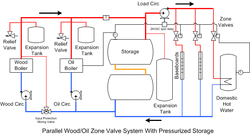When I plumb in my storage tank this spring I am replumbing the rest of the system to match the 'simplest pressurized storage' diagram above.
My question is where on my DHW tank, which is a standard electric hot water tank, should I put the sensor which tells the zone valve to open?
If at the top, won't it call for heat too late, when the tank is mostly empty of hot water, or will the tank be non-stratified enough to trip the sensor after just some water has been removed?
My question is where on my DHW tank, which is a standard electric hot water tank, should I put the sensor which tells the zone valve to open?
If at the top, won't it call for heat too late, when the tank is mostly empty of hot water, or will the tank be non-stratified enough to trip the sensor after just some water has been removed?


